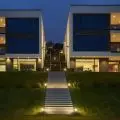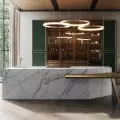The story of Plac Nowy, located in the heart of Krakow's Kazimierz district, a section of the city listed as a UNESCO World Heritage Site, is a tale of unrealized ideas, the replacement of residents with tourists and the chaos that has taken over one of the most important spaces in the historic fabric of the city.
The square, shaped like a trapezoid, was established in the nineteenth century. In its center in 1900 was built Okrąglak, a brick commercial pavilion that is now best known for its casserole outlets. Over the years, the square has turned into a disorderly space dominated by tourists, partygoers, and traffic, lack of parking spaces and sheds and stalls sprouting on its surface have become a problem.
left: view of the square, 1930; right: view of the square, 2009
left: photo: Stanislaw Mucha; right © Lewicki Łatak Design Office
a place with a strong identity
In search of new ideas, a competition for a design to modernize the New Square was decided in 2009. The first prize was won by a proposal from the Lewicki Łatak Design Bureau team. The Identity Matrix, as the architects called their project, aimed to restore the quality of the place from the pre-war times (without permanent shelters and stalls) while maintaining its strongly defined character. Piotr Lewicki and Kazimierz Łatak proposed to grind up the existing concrete pavement of the square and use the raw material to build a new facility. The height stratification of the site on the south side was to be used to place commercial booths under the pavement, and the upper level was to provide a stage for public events.



visualization of the project
© Lewicki Łatak Design Office
Twelve years have passed since the competition. Despite the passage of time, does the awarded project respond to today's challenges?
Certainly today we would put a slightly different concept for the development of this square, nevertheless the assumptions of our competition work are still valid: the New Square is a place with a very strong identity. It is a valuable attribute and worth preserving. The square should not change its character, it should also continue to be a place of trade, both inside the Okrąglak building and outside, in temporary stalls. I emphasize the word temporary, as I consider the permanent fixation of any structures in the New Square to be an error in assumptions.
Illustrations of market squares in Lyon, Turin and Rome clearly show the way commerce functions in such places: at a certain hour the stalls are rolled up, the pavement is cleaned, the place changes its face and is ready for more refined functions. The New Square functioned in the same way before the war, as can be perfectly seen in historical photos.
We sometimes glance at media reports about the municipality's plans when it comes to the development of Nowy Square. In our opinion, this square requires, first of all, deconstruction, i.e. dismantling and removal of all the "temporary" canopies and kiosks that have made themselves comfortable there. It also requires, of course, renewal of the pavement, damaged stairs and other development elements.
What it doesn't require - because of the strong self-identity mentioned at the outset - are the trendy and often infantile ideas spouted from the sleeve by those emotionally involved in the city's issues, most often otherwise full of good intentions. Trees (in the ground or in pots, which historically never existed in the New Square), beaches made of sand, painting the asphalt green, swings or other interventions similarly detached from the character of the place, we view strongly critically," says Piotr Lewicki, co-author of the project selected in the competition.
twelve years later...
For years the project of the Cracow architects did not live to see implementation. Eleven years after the competition was decided, in October 2020, a tender was announced to develop a concept for the development of the New Square in terms of reconstruction of sidewalks, the surface of the square, technical infrastructure and elements of small architecture. In February of this year, a contractor was selected - the DAKUZO architecture & branding studio, which, on the basis of surveys conducted among residents of the square and Kazimierz, people professionally connected with the area, residents of other parts of the city andtourists (in total, based on more than 800 opinions) created a preliminary study of concept variants, which in May were subjected to public consultations (a report on the consultations will be presented in June, the final concept for the development of the square should be ready in October this year.).



view from the side of Esther and Isaac streets
© DAKUZO architecture & branding
In their initial proposal, designers from the DAKUZO office focused on multifunctionality (rest and recreation, food and beverage, retail and events) and openness of the square. They suggested clearing it of secondary tissues and leaving the Okrąglak building to create an open space filled with mobile or temporary elements of urban furniture. The architects' concept includes, among other things, the leveling of the pavement and leveling of level differences, the creation of a green square planted with tall greenery in place of the existing public restrooms building, and proposals for the organization of traffic and parking spaces. The architects designed circular mobile benches with greenery, a mobile stage, unified modules of terraced connected gazebos of food gardens and a skeletal, temporary structure of the market, whose interconnected stalls in the shape of a polygon would refer to the lump of Okrąglak.



view of the square with temporary market and food gardens
© DAKUZO architecture & branding
a new look at the square
Michal Pyclik, spokesman for the Board of Roads of the City of Krakow, when asked about the reason behind the decision to tender for the reconstruction of the square despite the competition that was decided in 2009, why the concept of the Lewicki Łatak Design Bureau was not realized at the time, what happened to the square over the years, what idea the City has for the new Nowy Square and what clues have been gathered so far during public consultations, answered:
As you noted, the competition was held more than ten years ago. We decided that this is enough time and the expectations of residents have changed enough in the city that it is worth taking a fresh look at the square, its functions and residents' expectations. The competition entry did not include public consultations, and we wanted to see what residents' expectations are now.
The redevelopment of New Square was never introduced into the city budget, although it was reported - other investments were considered more urgent by the RMK. In the meantime, only ongoing maintenance work was carried out, and experiments and changes in traffic organization were made to make the space more suitable to current needs.
We are waiting for the final concept, but at the moment it seems that the predominant need is for a multifunctional square with the Roundhouse as the center and less overwhelming commercial stands - while increasing the pedestrian area including those with limited mobility. Unfortunately, but the main demand - greening the square - is unlikely to happen for preservation reasons.
what's next?
On May 11, a meeting was held as part of the public consultation on the development of the square, during which designers answered questions about the preliminary concept:
One of the demands that came up during the online meeting was the issue of the mode in which the designer was selected. A commenter suggested that the concept for such important public spaces should be selected through a competition, and if the design selected years ago required revisions, they should be developed by a team selected through an open procedure.
A fair and transparent architectural competition, held after extensive public consultations, would have a chance to select a design tailored to the space, responding to the needs and challenges of the post-square, and creating a friendly space for the city's residents. Although the City has opted for a bidding process, it is gratifying to see the openness to the voices of those interested in the future of New Square. So it remains to wait for the lessons learned.



























































